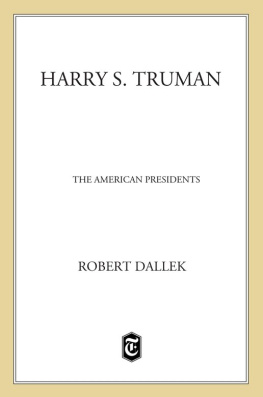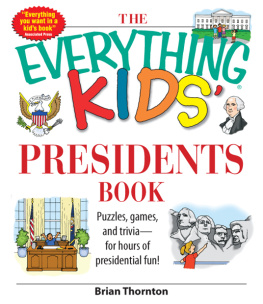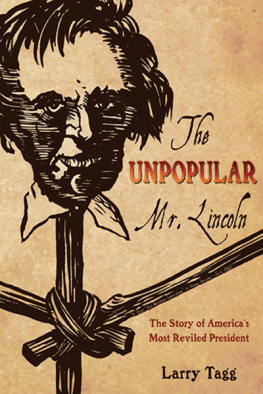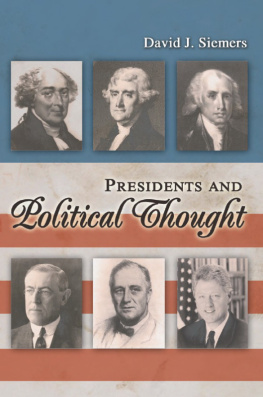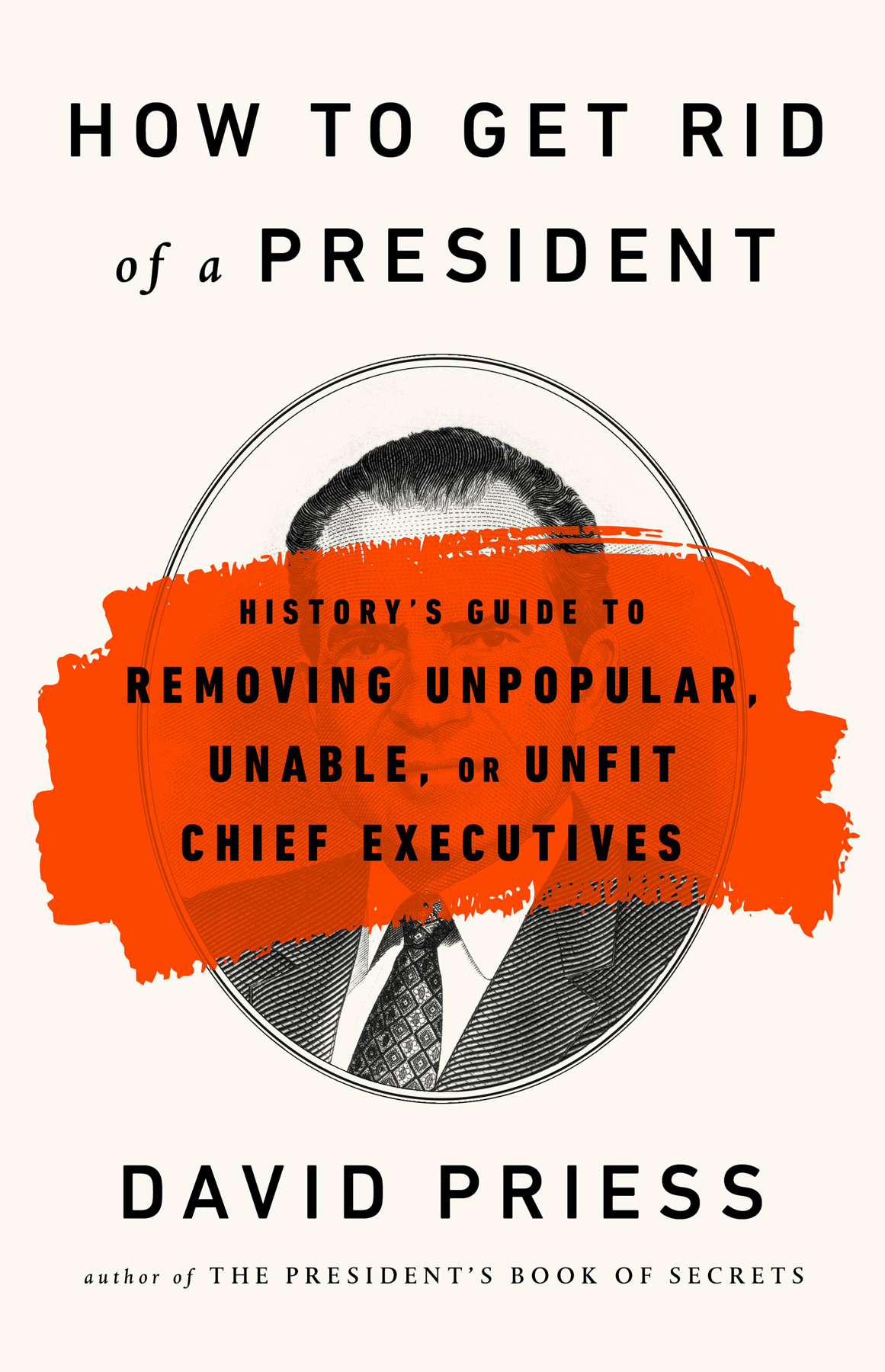Copyright 2018 by David Priess
Cover design by Pete Garceau
Cover illustration copyright iStock/Getty images
Cover copyright 2018 Hachette Book Group, Inc.
Hachette Book Group supports the right to free expression and the value of copyright. The purpose of copyright is to encourage writers and artists to produce the creative works that enrich our culture.
The scanning, uploading, and distribution of this book without permission is a theft of the authors intellectual property. If you would like permission to use material from the book (other than for review purposes), please contact permissions@hbgusa.com. Thank you for your support of the authors rights.
PublicAffairs
Hachette Book Group
1290 Avenue of the Americas, New York, NY 10104
www.publicaffairsbooks.com
@Public_Affairs
First Edition: November 2018
Published by PublicAffairs, an imprint of Perseus Books, LLC, a subsidiary of Hachette Book Group, Inc. The PublicAffairs name and logo is a trademark of the Hachette Book Group.
The Hachette Speakers Bureau provides a wide range of authors for speaking events. To find out more, go to www.hachettespeakersbureau.com or call (866) 376-6591.
The publisher is not responsible for websites (or their content) that are not owned by the publisher.
Editorial production by Christine Marra, Marrathon Production Services. www.marrathoneditorial.org
Set in 12-point Adobe Caslon
Library of Congress Control Number: 2018958064
ISBN 978-1-5417-8820-6 (hardcover), ISBN 978-1-5417-8821-3 (ebook)
E3-20181023-JV-PC
In memory of David Woods,
who dedicated his life to
supporting and defending the Constitution
and inspired others to do the same.
A regular and orderly change of rulers [is] the strongest guarantee against the approach of tyranny.
JAMES BLAINE
S TIFLING AIR FILLED Philadelphias crowded Pennsylvania State House, now Independence Hall, during the summer of 1787.
The distinguished men who had assembled there to revise the new countrys inadequate Articles of Confederation struggled through their discomfort. The stakes could hardly be higher: the structure for national governance they had crafted during their long and costly war had clearly begun to fail them in time of peace. They needed to improve what they had, or their fragile experiment would break up.
Among the most significant problems with the existing government the Constitutional Convention would address was the lack of an effective chief executive.
T HOMAS P AINE IN early 1776 had sparked a tidal wave of anti-monarchical sentiment with Common Sense, his pamphlet that took the colonies by storm. From that point on, the War of Independence stood for not only the protest against taxation without representation but also the inherent righteousness of republicanism over kingly rule.
Yet astute Americans saw that their makeshift confederation, lacking both taxing authority and reasonable enforcement powers, remained too weak to function effectively.
That tension between anti-monarchical sentiment and the palpable need for a stronger administrative leadership fell to George Washington, James Madison, Franklin, and dozens of other delegates to resolve as they worked to forge a new constitution that summer. Calls for a national executive authority, while no longer universally discarded, prompted energetic debate. James Wilson of Pennsylvania first proposed on June 1 that a single person hold executive power. South Carolinas Charles Cotesworth Pinckney and John Rutledge seconded the motion and spoke in favor of the one-man idea, respectively. The motion quieted most others in attendance, including the man presiding over the discussions. Only a few years had passed since then-general Washington had stepped away from power, despite some calls for him to take over as King George. Now he sat in silence, probably just as aware as his colleagues in the room that he was more likely than anyone in the thirteen former colonies to first occupy any proposed executive position.
Edmund Randolph of Virginia finally voiced the fears of pure republicans and much of the young nation, objecting to one-man rule with the claim that it inherently contained the ftus of monarchy.
T HE NEED FOR a strong executive clearly remained controversial, even at the Constitutional Convention, because many Americans then simply had no way to imagine how vesting national power in one person could end well. Few positive role models existed. Franklin, the most worldly of the delegates assembled in Philadelphia, on June 4 reminded his colleagues of the recent history of the United Netherlands. There, as he summarized it, the popular stadtholder had devolved into a hereditary position and seemed bound to become just another king. The Executive will be always increasing here, as elsewhere, he lamented, till it ends in a monarchy. Virtually everywhere these American wise men looked, they saw an unacceptable absence of liberty, an unacceptable abuse of executive power, or (more often) both.
The delegates fretted about the apparently universal tendency for leaders to amass power at the expense of the legislature and the peopleand, consequently, stay in charge too long. South Carolinas Pierce Butler, for example, noted that in all countries the Executive power is in a constant state of increase.
Eventually, of course, the delegates found their answer, now enshrined in the Constitution of the United Statesthe president of the United States. This single person would hold impressive powers: faithfully executing the laws, pardoning criminals, nominating judges, making treaties, and leading the armed forces as commander in chief. The best method of selecting this federal CEO prompted much debate. Navigating between the rocks of popular-will demagoguery (which, they worried, could result from direct election by the people) and puppet-presidency impotence (which, they worried, could result from election by the legislature), they devised a cumbersome electoral college system. By the founders logic, the people would choose their leader, but only indirectly.
Candidates for this powerful office would face no qualification tests beyond birth as a natural-born citizen, residency in the United States for fourteen years, and an age of at least thirty-five years.
W E TAKE FOR GRANTED that voters can kick the incumbent out and choose someone else as their leader. Its the simplest and cleanest way to get rid of a president, and it has happened to ten of the first forty-five presidents. But it almost wasnt so.
Delegates to the Constitutional Convention debated both the length of the presidents term and whether he would face reelection at all. Pennsylvanias Gouverneur Morris said if the people were to elect the chief executive, they would never fail to prefer a man of distinguished character and of continental reputation. Maybe, King suggested, power should be held indefinitely, as long as the occupant of the office maintained good behavior, to be assessed by the legislature.
Wiser heads argued for more debate. Madison declared that any plan letting Congress constantly judge good behavior would undermine the separation of powers he had been lobbying for. Mason weighed in, calling any presidential service plan without a fixed term a softer name only for an Executive for life and an easy step to hereditary Monarchy.to get there, but this back-and-forth eventually got them to settle on a four-year term, with no restriction on reelection. Arguments from delegates like Alexander Hamilton for property or experience requirements failed to make it into the Constitution. The American people at the ballot box, mediated through electors from each state, would henceforth decide which candidate proved most worthy of the highest office in the land.


